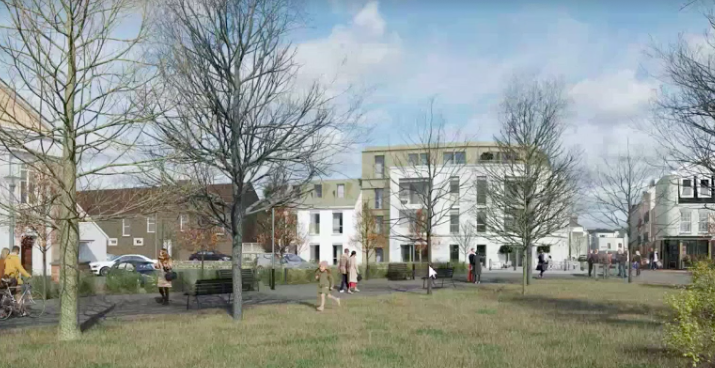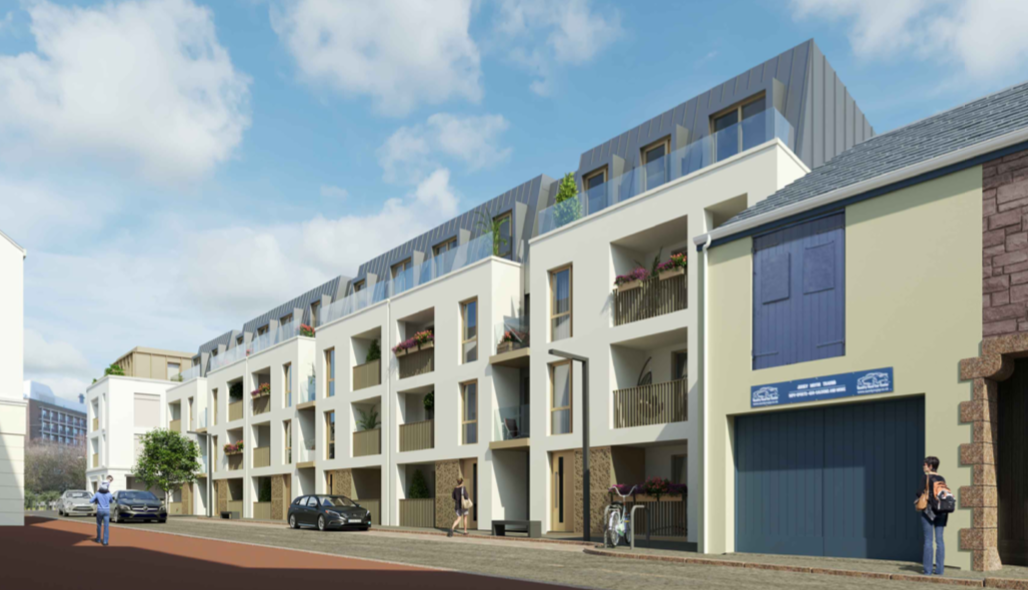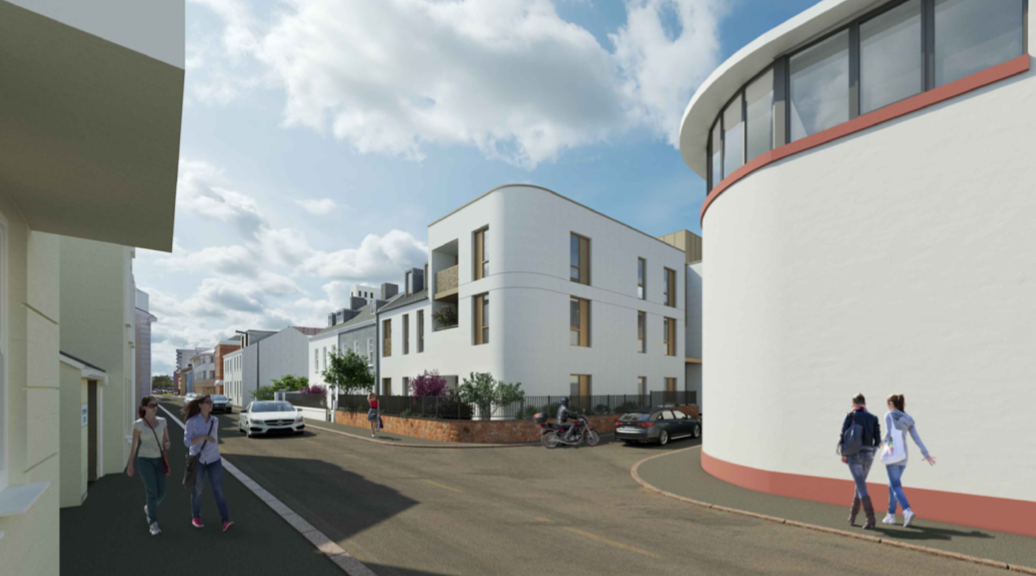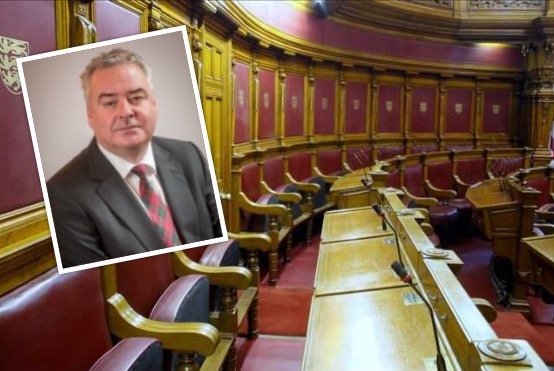


Plans to redevelop a 19th century former brewery site into 96 flats with office and retail space have been approved by the Planning Committee – despite the loss of a listed building – to provide “stimulus” to the local economy in the wake of the pandemic.
Randalls have operated on the site from the early 1800s, and put the redevelopment plans forward last year.
The plans include the demolition of the brewery itself to make way for 32 one-bedroom flats and 64 two-bedroom flats, spread across five blocks varying from three to five storeys with 75 parking spaces and 110 spaces for cycles.
The redevelopment will also make room for two retail units on the south-west of the site and office space.
They come as Randalls has decided to relocate its current warehouse and distribution operations to a more suitable location closer to Jersey’s main harbour.

Pictured: 96 new homes will be built on the former brewery site.
Planning Officer Ginny Duffell, who recommended the application for approval, explained she had worked with Randalls Limited, through the Jersey Architecture Commission, to reduce the scale of the development.
She described the latest version of the scheme as an “enormous improvement” on the first one.
She told the Planning Committee the plans included the destruction of a listed building at 28-30 Cannon Street, explaining the scheme wouldn’t be viable if it was to be restored.
The plans went through in May 2019 and the Planning Department hadn’t received any letters of representation, neither were concerns or objections raised, by the time the application came before the Planning Committee.
However, Tracey Ingle, Principal Historic Environment Planner, raised concerns during the hearing, regarding the loss of the listed building and the impact of the development on its setting.

Pictured: Randalls said the site was no longer suitable for their needs.
She said there was no question the listed buildings – which she described as mid-19th century houses that had formed part of the early development of St. Helier - had value and could be retained and reused, in a similar way as to the redevelopment of Pitt Street, despite the applicant’s claims to the contrary.
She said she believed there was profit in the scheme even without their demolition and suggested the applicant may have exaggerated how much it would cost to renovate them.
She urged the Planning Committee to reject the application, which she said would give the applicant the opportunity to “sharpen their pencils and deliver an imaginative scheme."
Mrs Ingle also suggested the main building could be “tuned down” in terms of scale, due to concerns over its impact on neighbouring buildings, such as All Saints Church and the Parade Pub.
Anthony Gibb, a Designer and Historic Buildings Consultant who sits on the Architecture Commission, credited Randalls for taking the JAC’s comments on board, including keeping a courtyard at the back of building.
But he voiced concerns on the 10-metre gap between two of the buildings, which he suggested would result in the lower floors receiving only a limited amount of sun.
“It might not be a very nice place to live,” Mr Gibb said.
He also suggested the design of the corner building did not justify the loss of the listed buildings. “In design terms the scheme is ok, but it could be better,” he said.
He stated that, according to the Commission, the scheme hadn’t been finessed, adding that, while there were benefits, they couldn’t be described as overwhelming.
“We can’t support regeneration for the sake of regeneration,” he said.
The Chamber of Commerce backed the proposals in an unusual move. In a letter read to the Committee, Chief Executive Murray Norton said the scheme would not only remove “unsightly building” from the area, but also help in the recovery of the island’s economy.
Ian McDonald, Director of Axis Mason, the architects in charge of the project, argued the scheme would turn the area into “a really pleasant healthy place to live”.
Antony Farman, Consultant at MS Planning, assured the Planning Committee that retaining the listed building would make the scheme unviable, adding that their architectural and historic interest was limited.

Pictured: Gavin Reid, Managing Director of Randalls.
Gavin Reid, Managing Director of Randalls, also addressed the Planning Committee. He explained that having reach point where the site was no longer suitable for Randalls’ needs, the company had sought to get planning approval to redevelop the site for housing and the “sympathetic restauration” of Clare House and stables.
He said that investment in hospitality was key in the wake of the covid-19 pandemic and that a Planning Approval would help Randalls write its next chapter and reinvest capital gains in new acquisitions.
He argued the scheme would help the business grow in the wake of covid-19, provide housing to islanders, restore historic buildings and add heritage value to this area of town.
Deputy Kirsten Morel said there was tension between the benefits of the scheme and the demolition of two listed buildings.
“I cannot get beyond the fact that Jersey needs housing desperately… We will need project of this sort of scale to provide a stimulus,” he said.
While he said rejecting the application might force Randalls to “go back to the drawing board”, he said he wasn’t willing to take the risk due to the current economic situation, despite regretting the loss of the listed building.
Deputy Rowland Huelin also gave his approval, noting that the involvement of Randalls with the Planning Department and JAC was “encouraging”.

Pictured: Deputy Russell Labey, Chairman of the Planning Applications Committee.
The decision was a bit more difficult for Trinity Constable Philip Le Sueur, who described himself as “great supporter of heritage”. While he said he didn’t put much weight on the viability of the scheme, he eventually approved it.
Deputy Graham Truscott described the area as “negative” and “very draining”, noting that the backing of St. Helier Constable, Simon Crowcroft, was reassuring.
He also approved the scheme.
The Committee’s Chairman, Deputy Russell Labey, said he would have given Ms Ingle one more opportunity to retain the listed buildings, had his vote been a “casting” one.
“I do not believe we should be knocking down early mid-18th century buildings in St. Helier, especially the unremarkable ones because the unremarkable ones are most threatened. But what chance did they have once we got to this stage?” he said.
He, however, opted to “listen to his committee” and approved the scheme.
Comments
Comments on this story express the views of the commentator only, not Bailiwick Publishing. We are unable to guarantee the accuracy of any of those comments.